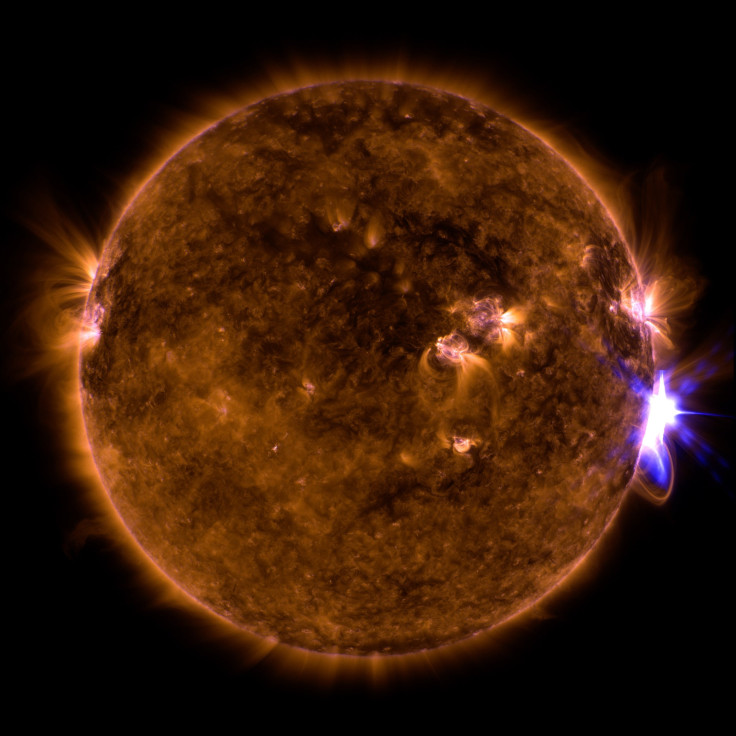Sun Belches Out Intense Solar Flare; Event Causes Radio Blackouts [Video]
KEY POINTS
- The Sun emitted a massive X-class solar flare Tuesday
- The bright flash of the flare can be seen in a video shared by NASA
- Radio blackouts were experienced in Australia, New Zealand and Southeast Asia
The Sun belched out yet another strong solar flare, and NASA's Solar Dynamics Observatory (SDO) captured a video of the intense event. The X-class event reportedly caused radio blackouts in some parts of the world.
The solar flare, classified as an X1.2 flare, peaked at 10.33 p.m. ET on Tuesday, NASA noted in a release. The agency shared a video of the solar flare as captured by the SDO, which is constantly keeping watch on the Sun.
The intense burst can be seen as the bright flash on the lower right part of the view of the Sun.
The Sun emitted a strong solar flare on March 28, 2023, peaking at 10:33pm ET. NASA’s Solar Dynamics Observatory captured an image of the event, which was classified as X1.2: https://t.co/3ft4yBOzKR pic.twitter.com/RPdc6IIYvn
— NASA Sun & Space (@NASASun) March 29, 2023
Solar flares are incredible bursts of energy from the Sun and such X-class flares are "the most intense" ones. X-class flares are said to be the largest explosions in the solar system. The most powerful flare measured so far happened in 2003, which was so strong that the sensors cut out at X28. Later on, it was estimated to be a massive X45 flare.
"Flares and solar eruptions can impact radio communications, electric power grids, navigation signals, and pose risks to spacecraft and astronauts," NASA noted.
This was what happened with the current flare, which reportedly caused a "strong" radio blackout event Wednesday. According to the National Oceanic and Atmospheric Administration's (NOAA) Space Weather Prediction Center (SWPC), parts of the sunlit side of the Earth experienced "temporary degradation or complete loss" of high-frequency radio signals.
A R3 (Strong) HF radio blackout event occurred due to a X1.2 flare from Region 3256 on 28 March, 2023, at 10:33 pm EDT (29/0233 UTC). Visit https://t.co/YLUbTRM02y for any additional information and updates. pic.twitter.com/qqfq5YErrI
— NOAA Space Weather (@NWSSWPC) March 29, 2023
It was experienced in Australia, New Zealand and Southeast Asia, reported The Weather Channel. This means some radio operators may have faced signal loss below 30 MHz for about an hour.
The Sun has been quite active of late as it approaches the maximum in its 11-year solar cycle, the peak of which is expected to be in July 2025. This year alone, we've had quite a few X-class solar flares.
It appears the Sun will have a bit of a rest in the next couple of days, according to the SWPC. The center noted that no "minor or greater" geomagnetic storms, solar radiation storms or radio blackouts are expected.
"No significant active region flare activity is forecast," it added.
3-Day Forecast Issued 2023 Mar 30 0030 UTC:
— NOAA Space Weather (@NWSSWPC) March 30, 2023
The greatest expected 3 hr Kp for Mar 30-Apr 01 2023 is 4.33 (below NOAA Scale levels).
S1 or greater: 10%, 5%, 5%. R1-R2: 25%, 10%, 10%.
R3 or greater: 10%, 5%, 5%. https://t.co/gPw8AeBd9u
As distant and unfamiliar as space weather may seem, it can actually have an impact here on Earth, especially with the technology that we use. For instance, space weather can produce events that may disrupt power lines, potentially causing power outages. It may even impact the satellites that are needed for communication and weather forecasting.
Just like with weather predictions here on Earth, efforts are continuously underway to help prepare the world for such space weather events.

© Copyright IBTimes 2024. All rights reserved.






















